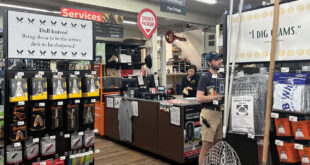Successful business owners know workplace safety is critical to their day-to-day operations.
Employee and customer safety should remain at the forefront of everyone’s workday, and safety standards should be woven into your business’s policies and procedures. By prioritizing safety, you demonstrate your commitment to protecting your employees and customers from any accidents that could happen in your store, and strengthen your business’s ability to grow and thrive.
Everyone in your business should share a vision for safety that is demonstrated by core values and behaviors, where everyone walks the talk. By being proactive and tackling unsafe acts and conditions before they result in accidents, you create your safety culture.
Four Steps to a Safety Culture
To get you started in building a safety culture, follow these four steps.
- Assess safety risks in your store. The risks you face on a daily basis must be understood in order to build a safer workplace. For every task and every associated risk, there must be an assessment and safety-based changes should be taken into account. These risks could include potential slips on wet floors or back injuries from incorrectly unloading boxes of products. The risks will vary based on the work environment.
- Carefully consider past incidents and near misses. Recognize that past incidents can aid you in determining root causes and detect risks and exposures that endanger the safety of your employees, your customers and the success of your business.
- Avoid injuries by recognizing the risks. Your goal should be to prevent or mitigate accidents by assessing your work policies and procedures, employee work practices and behaviors, buildings, stock and equipment and building locations. Once the practices and procedures are in place and understood, be sure to hold people accountable to your safety culture.
- Design a safety plan and stick to it. Your goal should be to eliminate or minimize risk by following the policies and procedures set forth in the safety plan.
- Create engagement. Your employees should be engaged and committed to a safety culture.
- Remain focused on the risks and exposures identified during your assessment.
- Prioritize your risks and exposures and focus on the risks of greatest concern. Carefully consider frequency and severity of the loss potential, in addition to the opportunity to prevent or mitigate risks.
- Determine solutions and the appropriate resources. Get your employees involved to help implement positive change and stay focused on safety goals. Make sure your management team is aware of the safety plan and is committed to finding the right solution for your operation.
- Execute your plan. Communicate the plan, explain the details, and conduct employee training and reviews to ensure all employees understand the continual focus on safety.
- Communicate and educate – go beyond what is written on paper and continually communicate and educate your employees about the safety program. Your goal is to create a team of proactive and engaged employees that can effectively deliver the content in your safety plan.
- Observe, assess and improve your plan. As your business grows and thrives, so you should your safety program. Be sure to regularly assess your plan to ensure it still matches the goals of your business and fits the needs of your operation. As new employees come on board, be sure to maintain the same level of commitment and training to ensuring all staff are properly trained and educated in your safety plan.
- Continually monitor the plan, request feedback on the plan’s effectiveness, and maintain a proactive work environment committed to safety.
- On a regular basis, examine your safety performance against the plan’s objectives and expectations.
- Be prepared to adjust the safety plan when necessary.
- Celebrate successes, such as a full year without any workplace injuries. Safety successes should be communicated and celebrated!
A focus for Member Insurance Agency is making sure clients have the tools necessary to build an effective safety culture. For more information, contact Mary-Jo Salzburg at 847-277-2601 or email nrha@memberinsurance.com.
 Hardware Retailing The Industry's Source for Insights and Information
Hardware Retailing The Industry's Source for Insights and Information








